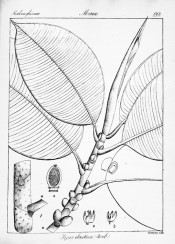Ficus elastica Roxb.
Frost tender, evergreen, many-branched tree with oblong, leathery, glossy, dark green, often red-flushed, leaves to 45cm long. Oblong yellow figs are produced in pairs or clusters on mature trees. To 60m. [RHSE, Hortus]. It has been used as a source of natural rubber but the principal source is the Pará rubber tree (Hevea brasiliensis).
Horticultural & Botanical History
Introduced to Britain in 1815. ‘Besides the cultivated figs, there are a vast number of other species belonging to Ficus, all natives of the tropics, where they arrest the attention of the travellor by their grateful shade, their enormous growth, or by their manner of sending down roots from their branches to support and extend their distorted arms, as in the Banyan-tree.’ [JD].
‘Ficus elastica, Roxburgh. Upper India, to the Chinese boundary known as far as 28 degrees 30 minutes north latitude. A large tree, yielding its milk-sap copiously for caoutchouc, i.e., the kind called Assam Rubber. Roxburgh ascertained sixty years ago that India-rubber could be dissolved in cajaput oil (so similar to eucalyptus oil), and that the sap yielded about one-third of its weight caoutchouc. This tree is not of quick growth in the changeable and often dry clime of Melbourne, but there is every prospect that it would advance rather rapidly in any unutilised humid forest gullies, and that copious plantations of it there would call forth a new local industry. This tree has grown in Assam to 112 feet with 100 aerial roots in thirty-two years (Markham). The import of all kinds of caoutchouc into GreatBritain during 1874 amounted to 129,168 cwt., worth 1,326,605 pounds. Markham and Collins pronounce the caoutchouc of F. elastica not quite so valuable as that of the Heveas and Castilloas of South America. Heat and atmospheric moisture greatly promote the growth of F. elastica. Like most other Fig-trees it is easily raised from seed. A tree of F. elastica is tapped in Assam when twenty-five years old. After fifty years the yield is about 40 Ibs. of caoutchouc every third year (Markham and Collins). Mr. S. Kurz states that F. laccifera (Roxburgh), from Silhet is also a caoutchouc Fig-tree, and that both this and F. elastica yield most in a ferruginous clay-soil on a rocky substratum; further, that both can bear dryness, but like shade in youth.
Several other species of tropical Figs, American as well as Asiatic, are known to produce good caoutchouc, but it is questionable whether any of them would prosper in extra-tropical latitudes; nevertheless for the conservatories of Botanic Gardens all such plants should be secured with a view of promoting public instruction.’ [Mueller - Select Extra-Tropical Plants readily eligible for Industrial Culture or Naturalisation (NSW Edition) p.140/1881].
Figured in Icones plantarum Indiae Orientalis. [Wight vol.2, p.663/1840-53].
History at Camden Park
Listed only in the 1857 catalogue [T.446/1857].
Notes
Published Mar 16, 2009 - 04:20 PM | Last updated Jul 28, 2010 - 12:38 PM
| Family | Moraceae |
|---|---|
| Category | |
| Region of origin | Himalayas to Java |
| Synonyms | |
| Common Name | India rubber fig, India rubber tree |
| Name in the Camden Park Record | Ficus elastica |
| Confidence level | high |
